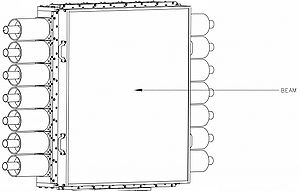MainPage:Nuclear:KaonDetector
| This page is under construction. It requires a review! |
| ⇐ Back to the Main_Page |
Latest news
New aerogel tiles arrived for the Kaon Aerogel Detector! They have refractive index of 1.015... extremely fragile! See pictures on the Construction link bellow.
The pre-assembly of the Kaon Aerogel was done! Check status on the Construction link bellow.
Tools for the detector characterization
Besides the detector construction itself, some tools are being developed for the characterization of it. Simulations (e.g. on the interaction of particles with the detector and on the optics of the detector for the PMT measurement) and components characterization (e.g. PMT and aerogel blocks characterization) are being developed by the group.
The reports on each part of the work on the detector can be seen in the following pages:
 Pictures |
 Construction details |
 Reference Material |
Universities consortium for the construction of this new detector
As part of the upgrades on the Hall C at JLab, a new Kaon Aerogel Detector is under construction by a collaboration of researchers on Particle Physics, lead by Dr. Tanja Horn.
The main purpose of this detector is to be part of the new spectrometer that is being constructed at Hall C, the SHMS.
For the execution of the project, a consortium was established with the following institutions:
- The Catholic University of America
- University of South Carolina
- Mississippi State University
- Florida International University
Two other partners are also engaged on this project, as unfunded institutions:
This project is founded through a NSF grant: PHY-1039446.
General Aspects on the Detector
The design of this detector is based on proven technology and benefits from many years of experience that JLab acquired on the usage of aerogel detectors.
The idea behind an aerogel detector is to make possible the triggering of events (particle) from a nuclear reaction for the selection of particles momentum. Together with other information on the experiment (e.g. beam energy and spectrometer angle), it makes possible the particle identification (PID) from a nuclear reaction.
The special characteristic of an aerogel detector for the PID is a threshold that happens with the Cerenkov radiation phenomenum. Only particles above a threshold velocity will produce this effect. The threshold is directly related to the refractive index of the aerogel inside the detector.
The detector that is under construction in this project will feature three trays of aerogel, each with a different refractive index. This design will provide the flexibility to change the threshold on the momentum selection of the particles, and thus cover the full kinematic range needed by the experiments. Aerogel material of two refractive indices is already at hand.
Related papers
It follows a list of papers and other materials related to the Kaon Aerogel Detector.
Nuclear Physics
- T. Horn et al, Scaling study of the pion electroproduction cross sectionsand the pion form factor, arXiv:0707.1794v1 - File:Scalling study of the pion electroproduction cross sections and the pion form factor.pdf
Simulations
- D.W. Higinbotham, Diffusely reflective aerogel Cherenkov detector simulation techniques, Nuclear Instruments and Methods in Physics Research A 414 (1998) 332-339 - File:Aerogel Cerenkov detector simulation techniques.pdf
Aerogel Properties
- S. Henning, L. Svensson, Production of Aerogel Properties, Physica Scripta, Vol. 23, 697-702, 1981.
- Arlon Hunt and Michael Ayers, Silica Aerogels, Lawrence Berkeley Laboratories: Microstructured Materials Group. http://www.sps.aero/Key_ComSpace_Articles/TSA-009_White_Paper_Silica_Aerogels.pdf (consulted in December 16, 2011) - File:Aerogel Aerlon SilicaAerogels.pdf
- A. Emmerling et al, Relationship between optical transparency and nanostructural features of silica aerogel, Journal of Non-Crystalline Solids 185 (1995) 240-248 - File:Relationship between optical transparency and nanostructural features of silica aerogels.pdf
- I. Adachi et al, Study of highly transparent silica aerogel as a RICH radiator, Nuclear Instruments and Methods in Physics Research A 553 (2005) 146–151 - File:Study of highly transparent silica aerogel as a RICH radiator.pdf
- I. Adachi et al, Study of a silica aerogel for a Cherenkov radiator, Nuclear Instruments and Methods in Physics Research A 595 (2008) 180–182 - File:Study of a silica aerogel for a Cherenkov radiator.pdf
- A. Yu. Barnyakov et al, Influence of water on optical parameters of aerogel, Nuclear Instruments and Methods in Physics Research A 598 (2009) 166–168 - File:Influence of water on optical parameters of aerogel.pdf
- A.R. Buzykaev et al, Measurement of optical parameters of aerogel, Nuclear Instruments and Methods in Physics Research A 433 (1999) 396-400 - File:Measurement of optical parameters of aerogel.pdf
- A.F. Danilyuk et al, Recent results on aerogel development for use in Cherenkov counters, - Nuclear Instruments and Methods in Physics Research A 494 (2002) 491–494 - File:Recent results on aerogel development for use in Cherenkov counter.pdf
- A.Yu. Barnyakov et al, Development of aerogel Cherenkov detectors at Novosibirsk, Nuclear Instruments and Methods in Physics Research A 553 (2005) 125–129 - File:Development of aerogel Cherenkov detectors at Novosibirsk.pdf
- A. Buzykaev et al, Aerogels with high optical parameters for Cherenkov counters, Nuclear Instruments and Methods in Physics Research A 379 (1996) 465-467 - File:Aerogels with high optical paramenters for Cherenkov counters.pdf
- K. Arisaka et al, Four-layer aerogel Cherenkov counter, Journal of Non-Crystalline Solids 225 1998 375–380 - File:Four-layer aerogel Cherenkov counter.pdf
- E. Aschenauer et al, Optical characterization of n=1.03 silica aerogel used as radiator in the RICH of HERMES, Nuclear Instruments and Methods in Physics Research A 440 (2000) 338}347 - File:Optical characterization of n 103 silica aerogel used as radiator in the RICH of HERMES.pdf
Experimental Results
- B. Tonguc et al, The BLAST Cherenkov detectors, Nuclear Instruments and Methods in Physics Research A 553 (2005) 364–369 - File:Blast Cerenkov detectors.pdf
- R. Asaturyan et al, The aerogel threshold Cherenkov detector for the High Momentum Spectrometer in Hall C at Jefferson Lab, Nuclear Instruments and Methods in Physics Research A 548 (2005) 364–374 - File:HMS Aerogel Cerenkov Detector.pdf
- G. Adams et al, The CLAS Cherenkov detector, Nuclear Instruments and Methods in Physics Research A 465 (2001) 414–427
- S. Marrone et al, Performance of the two aerogel Cherenkov detectors of the JLab Hall A hadron spectrometer, Nuovo Cimento Vol. 124B, issue 1, (2009) 99.
- Y. Allkofer et al, A new aerogel Cerenkov detector with wavelength shifter, Nuclear Instruments and Methods in Physics Research A (2007).
